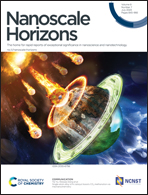Nonvolatile electro-mechanical coupling in two-dimensional lattices†
Abstract
Electro-mechanical coupling is of great interest for applications in sensors, actuators and energy harvesters. While the control of electrical charge by mechanical force has been studied extensively, reverse coupling is rarely explored, especially in two-dimensional (2D) lattices. Herein, we propose a novel mechanism for electro-mechanical coupling that realizes the electric field switching of the dimensions of a 2D lattice in a reversible and nonvolatile fashion, through the mediated strength of interlayer interactions in ferroelectric bilayer systems. Based on first-principles calculations, the validity of this mechanism is demonstrated in a series of real bilayer materials, i.e., MoS2/ReIrGe2S6, Sb/In2Se3 and bilayer In2Se3. The interface differences due to polarization play a crucial role in realizing such nonvolatile electro-mechanical coupling, and the underlying physical origin is discussed. These explored phenomena and insights offer a novel avenue for the highly desired nonvolatile electric field control of mechanical strain.



 Please wait while we load your content...
Please wait while we load your content...